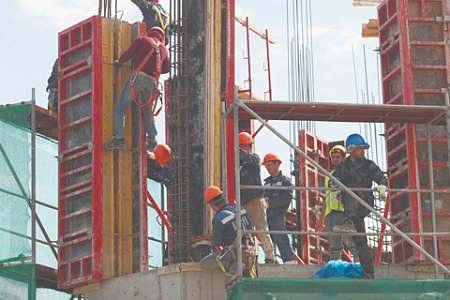
Tajikistan’s economy presents a startling paradox, boasting a projected GDP growth of 8.4% for 2025 while being critically dependent on a single, increasingly volatile source of income: its migrant workers in Russia. This fragile economic lifeline is now under severe strain following a widespread crackdown on migrants in the wake of the tragic Crocus City Hall attack, sending tremors through the entire Central Asian region.
In 2024, remittances from migrant laborers to Tajikistan soared to an estimated $6.4 billion, accounting for an astonishing 45% of the country’s $14.155 billion GDP. This figure, which surpasses foreign investment and official aid combined, places Tajikistan among the world’s most remittance-dependent nations. However, the official growth forecasts, cited in reports by institutions like the European Bank for Reconstruction and Development (EBRD), face scrutiny over whether they fully account for this massive, yet precarious, inflow of capital that sustains countless families and small businesses.
For years, this arrangement created a delicate geopolitical symbiosis. Russia secured a vital labor force to fill its demographic gaps and a key lever of influence in Central Asia. Meanwhile, Tajikistan and its neighbors found an essential outlet for their rapidly growing populations and a crucial source of national income. This balance seemed stable, with a high demand for workers ensuring a steady flow of both people and money. The post-Crocus environment has shattered that perception.
The attack triggered a sharp rise in anti-migrant sentiment across Russia, with a particular focus on citizens of Tajikistan. The backlash plunged the Tajik government into a state of panic, fearing that mass deportations could trigger a social explosion back home and destabilize a key member of the Collective Security Treaty Organization (CSTO). The brewing crisis was so severe that it required direct intervention at the presidential level between Moscow and Dushanbe to de-escalate tensions.
Despite diplomatic efforts, Russia is moving forward with tangible restrictions. New regulations are limiting migrant labor in key sectors such as construction, retail, healthcare, and taxi services. The Moscow region has already announced a 2025 ban on foreign citizens working under patents—a system used by Tajiks, Uzbeks, and others—in various retail and food service roles. Furthermore, a new policy will prevent children with poor proficiency in the Russian language from being admitted into school classes, creating another barrier to integration.
These measures navigate a gray area in Russian law, which officially prohibits labor discrimination but allows for exceptions to protect national security and balance the workforce. While the Russian government frames these restrictions as a means to prioritize its own citizens for employment, the long-term consequences remain uncertain. With Central Asia’s population continuing to grow, the pressure of migration will not disappear. Instead, the crackdown risks exacerbating social tensions, challenging regional stability, and forcing nations like Tajikistan to confront the profound risks of their economic dependency on Russia.
